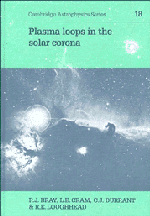Book contents
- Frontmatter
- Contents
- Preface
- Acknowledgements
- Other books by the authors
- List of abbreviations
- 1 Historical introduction
- 2 Cool loops: observed properties
- 3 Hot loops: observed properties
- 4 Flare loops: observed properties
- 5 Structure, dynamics and heating of loops
- 6 The plasma loop model of the coronae of the Sun and stars
- Additional notes
- Name index
- Subject index
6 - The plasma loop model of the coronae of the Sun and stars
Published online by Cambridge University Press: 22 October 2009
- Frontmatter
- Contents
- Preface
- Acknowledgements
- Other books by the authors
- List of abbreviations
- 1 Historical introduction
- 2 Cool loops: observed properties
- 3 Hot loops: observed properties
- 4 Flare loops: observed properties
- 5 Structure, dynamics and heating of loops
- 6 The plasma loop model of the coronae of the Sun and stars
- Additional notes
- Name index
- Subject index
Summary
Introduction
The preceding chapter has discussed the structure and heating of single plasma loops in the solar corona. We turn now to consider systems of loops, exploring the questions of the origin, evolution and global topology of plasma loops and their associated magnetic fields in the corona of the Sun and in the coronae of other stars.
Two major physical processes determine the structure and development of the plasma loops that are so frequently delineated in the solar corona. First, the coronal magnetic field in regions occupied by loops must conform to an elongated or tubular topology compatible with the presence of potential or force-free conditions in the corona (Sections 5.2.2, 5.2.3) and with the existence of spatially isolated sources with complex polarities intermingled in the photosphere. Secondly, the injection, transport and dissipation of matter and energy fluxes in the corona must be localized in and guided by this tubular magnetic topology. The anisotropic character of energy and mass transport coefficients in the presence of a magnetic field helps to explain this behaviour. However, anisotropic transport coefficients by themselves do not explain why only some magnetic tubes are delineated at any time. Spatially localized conversion and concentration of the mass and energy fluxes must also occur and, as we shall see, this aspect of the phenomenon is mediated by processes occurring beneath the visible layers of the Sun.
- Type
- Chapter
- Information
- Plasma Loops in the Solar Corona , pp. 403 - 480Publisher: Cambridge University PressPrint publication year: 1991

